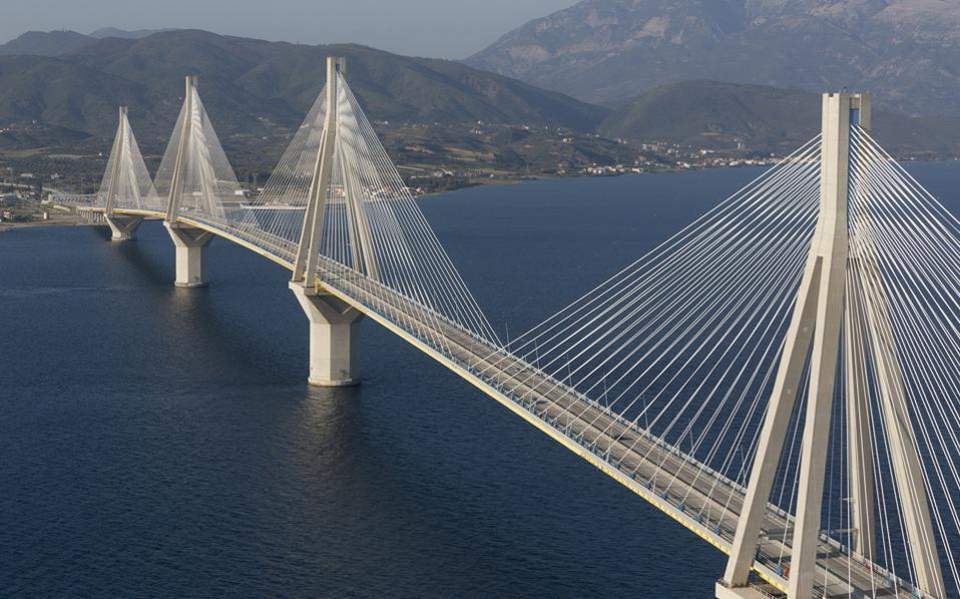Rio–Antirrio Bridge is the world’s longest multi-span cable-stayed bridge. It crosses the Gulf of Corinth near Patras, linking the town of Rio on the Peloponnese to Antirrio on mainland Greece.
Its official name is the Charilaos Trikoupis Bridge. Charilaos Trikoupis was a 19th-century Greek prime minister; he suggested the idea of building a bridge between Rio and Antirrio. The project was too expensive at the time, when Greece was trying to get a late start in the Industrial Revolution.
The 2,880 m (9,449 ft) long bridge (approximately 1.8 miles) dramatically improves access to and from the Peloponnese, which could previously be reached only by ferry or via the isthmus of Corinth at its extreme east end. Its width is 28 m (92 ft) — it has two vehicle lanes per direction, an emergency lane and a pedestrian walkway. Its five-span four-pylon cable-stayed portion of length 2,252 m (7,388 ft) is the world’s second longest cable-stayed deck.
This bridge is widely considered to be an engineering masterpiece, owing to several solutions applied to span the difficult site. These difficulties include deep water, insecure materials for foundations, seismic activity, the probability of tsunamis, and the expansion of the Gulf of Corinth due to plate tectonics.
Due to the peculiar conditions of the straits, several unique engineering problems needed to be considered. The water depth reaches 65 m, the seabed is mostly of loose sediment, the seismic activity and possibility of tectonic movement is significant, and the Gulf of Corinth is expanding at a rate of about 30 mm a year. For these reasons, special construction techniques were applied. The piers are not buried into the seabed, but rather rest on a bed of gravel which was meticulously leveled to an even surface (a difficult endeavor at this depth). During an earthquake, the piers should be allowed to move laterally on the seabed with the gravel bed absorbing the energy. The bridge parts are connected to the pylons using jacks and dampers to absorb movement; too rigid a connection would cause the bridge structure to fail in the event of an earthquake. It was also important that the bridge not have too much lateral leeway so as not to damage the piers. There is provision for the gradual expansion of the strait over the bridge’s lifetime.
The bridge was planned in the mid-1990s and was built by a French-Greek consortium led by the French group Vinci, and which includes the Greek companies Hellenic Technodomiki-TEV, J&P-Avax, Athena, Proodeftiki and Pantechniki. The consortium operates the bridge under concession under its G.E.F.Y.R.A., Greek for “bridge”, French-Greek Carrier of Oversea Connection of Rio–Antirrio ubsidiary. The lead architect was Berdj Mikaelian. Site preparation and dredging began in July 1998, and construction of the massive supporting pylons in 2000. With these complete in 2003, work began on the traffic decks and supporting cables. On May 21, 2004, the main construction was completed; only equipment (sidewalks, railings, etc.) and waterproofing remained to be installed.
The bridge was finally inaugurated on August 7, 2004, a week before the opening of the 2004 Summer Olympics in Athens. Olympic torchbearers were the first to officially cross its length. One of them was Otto Rehhagel, the German football coach who won the Euro 2004 Championships for Greece. Another was Costas Laliotis, the former Minister of Public Works during whose term the project had begun.
The bridge received the 2006 Outstanding Structure Award from the International Association for Bridge and Structural Engineering. In 2011 the bridge was featured on TV in an episode of Richard Hammond’s Engineering Connections.
SEE ALSO

